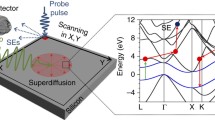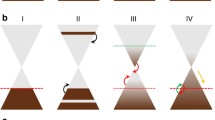Abstract
We investigate the carriers dynamics in bulk silicon using pump-probe spectroscopy. The experimental results are compared with theoretical calculations which combine for the first time the non-equilibrium Green’s functions theory with ab initio methods.
Access provided by Autonomous University of Puebla. Download conference paper PDF
Similar content being viewed by others
Keywords
- Conduction Band Minimum
- Bulk Silicon
- Carrier Dynamic
- Direct Optical Transition
- Interband Direct Transition
These keywords were added by machine and not by the authors. This process is experimental and the keywords may be updated as the learning algorithm improves.
Semiconductor nanostructures are the most promising building blocks for future electronic devices. In the light of a continuous progress in the realization and miniaturization of semiconductor devices, ultrafast carriers dynamics is a research field of paramount importance for these materials. The transient dynamics in silicon was extensively studied by different time-resolved experimental techniques, such as single color pump-probe reflectivity [1], transient grating diffraction and time resolved photoemission [2]. However the limited spectral range explored by pump-probe measurements and the rather complicated silicon band structure prevents to deeply understand the physical origin of the transient variation of silicon optical properties. Therefore a quantitative understanding of all the relaxation processes taking place after the excitation of a femtosecond laser pulse, is still lacking.
Here we use an optical pump-supercontinuum-probe technique to investigate the dynamics of the silicon dielectric function over an extended energy range. These experimental results are compared with theoretical calculation which combines for the first time the non-equilibrium Green’s functions theory with ab initio methods, like Density Functional Theory [3, 4].
The silicon electronic band structure is well understood both theoretically and experimentally. Silicon is an indirect gap semiconductor: direct optical transitions from the top of the valence band to the bottom of the conduction band occur for electronic states at the center of the Brillouin zone (\( \Gamma \) point) and close to the L critical point. Below the threshold of the direct optical transition, which is \( \approx \)3.3 eV, it is still possible for the valence band electrons to be promoted to the conduction band through excitation processes mediated by phonon scattering into the L and X valleys.
In this work we report on ultrafast transient reflectivity experiment in bulk silicon. Our pump-probe setup is powered by a regeneratively amplified Ti:sapphire laser system, providing 150 fs, 800 nm pulses at 1 kHz repetition rate. The electronic carriers are excited to the conduction band by the second harmonic (3.1 eV) and are probed by a broadband delayed pulse, in a spectral range between 1.7 and 3.6 eV. The probe pulse is generated by spectral broadening of a fraction of the fundamental light in a CaF2 plate. Upon pumping with the fluence of 1 mJ/cm2, we measure the transient reflectivity response reported in Fig. 1. The trace displays very rich temporal and spectral dynamics due to the interplay between different physical processes. An intense and narrow negative band peaked around 3.5 eV is ascribed to the bleaching of the interband direct transition by Pauli blocking due to the pump induced depletion of states at the top of the valence band around \( \Gamma \). The negative signal below 3 eV, increasing at lower probe energies, arises from the bleaching of the phonon mediated optical transitions. This interpretation is confirmed by the different temporal behavior below (2 eV) and above (3.5 eV) the direct transition threshold (Fig. 1c). This experimental result is consistent with the fact that direct optical transitions are Pauli blocked only by the photoinduced holes around \( \Gamma \) while, in the case of indirect transitions, the hot electrons relaxing towards the minima of the conduction band give an additional contribution to this process.
The DFT band structure is numerically computed within the standard LDA approximation applying a quasiparticle correction of 0.8 eV. The out of equilibrium Green function, constructed using quasiparticle energies and DFT wave-functions, is used to study the non-equilibrium dynamics of the system following a laser pulse excitation close to the experimental condition (pulse width = 110 fs and pulse energy = 3.3 eV). In this case electrons are directly injected from the valence to the conduction band, around \( \Gamma \), and then relax towards the conduction band minimum X due to electron-electron scattering, described within the out-of equilibrium GW approximation, and the electron-phonon scattering, described starting from the Fan Self-energy.
Figure 2 sketches the non-equilibrium carriers dynamics in bulk silicon. The electrons, initially injected close to the \( \Gamma \) point (Fig. 2a), relax towards the two minima L and X on a very fast timescale. Thereafter the population in L reaches its maximum at a delay time of \( \approx \)600 fs (Fig. 2b), while the complete relaxation towards the conduction band minimum takes more than 1 ps (Fig. 2c).
a First principles carriers dynamics in bulk silicon under a 110 fs laser pulse. The electrons and holes density is represented on the silicon band structure and projected on the energy axes to monitor the creation of two Fermi distributions with decreasing temperatures. Three temporal snapshots are here represented at t = 300 fs, before the maximum of the laser pulse, at t = 600 fs (b) and finally at t = 1.5 ps (c)
These preliminary numerical results can be used to compute the silicon transient dielectric function and then be compared with the experiments. This joint experimental and theoretical study of the transient silicon optical properties could pave the way to the quantitative understanding of several non-equilibrium physical phenomena in semiconductors.
References
Sabbah, A. J. et al. Femtosecond pump-probe reflectivity study of silicon carrier dynamics. Phys. Rev. B 66, 165217 (2002)
Ichibayashi, T. et al. Ultrafast relaxation of highly excited hot electrons in Si: Roles of the LX intervalley scattering. Phys. Rev. B 84, 235210 (2011)
Attaccalite, C. et al. Real-time approach to the optical properties of solids and nanostructures: Time-dependent Bethe-Salpeter equation. Phys. Rev. B 84, 245110 (2011)
Marini, A. Competition between the electronic and phonon mediated scattering channels in the out-of-equilibrium carrier dynamics of semiconductors: an ab initio approach. J. Phys. Conf. Ser. 427, 012003 (2013)
Acknowledgments
Futuro in Ricerca grant No. RBFR12SW0 J of the Italian Ministry of Education, University and Research.
Author information
Authors and Affiliations
Corresponding author
Editor information
Editors and Affiliations
Rights and permissions
Copyright information
© 2015 Springer International Publishing Switzerland
About this paper
Cite this paper
Dal Conte, S., Sangalli, D., Marini, A., Cerullo, G., Manzoni, C. (2015). Ultrafast Carriers Dynamics in Silicon: A Joint Experimental and Theoretical Study. In: Yamanouchi, K., Cundiff, S., de Vivie-Riedle, R., Kuwata-Gonokami, M., DiMauro, L. (eds) Ultrafast Phenomena XIX. Springer Proceedings in Physics, vol 162. Springer, Cham. https://doi.org/10.1007/978-3-319-13242-6_55
Download citation
DOI: https://doi.org/10.1007/978-3-319-13242-6_55
Published:
Publisher Name: Springer, Cham
Print ISBN: 978-3-319-13241-9
Online ISBN: 978-3-319-13242-6
eBook Packages: Physics and AstronomyPhysics and Astronomy (R0)






